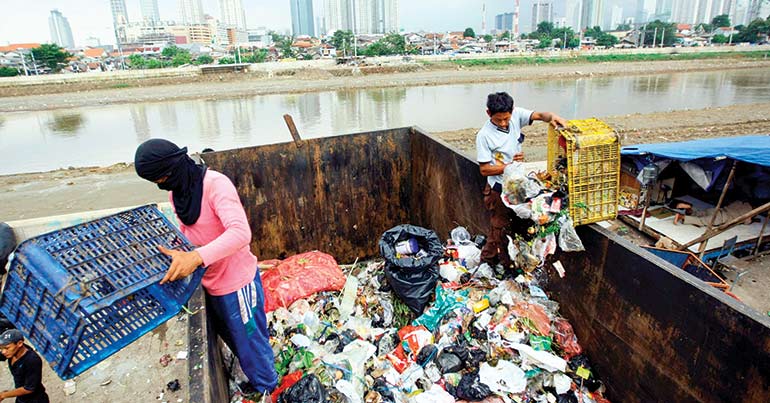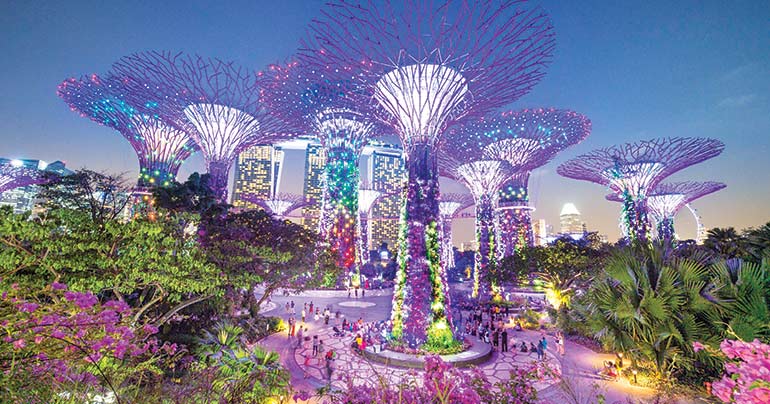It is 2050, and the cities of Southeast Asia are burning. Buckling beneath the weight of the hundreds of millions pouring in from wasted hinterlands once rich with rural life, these metropolises blaze with a heat buried beneath a haze of smog and filth. Streets choked with countless cars, motorbikes and trucks cut through urban slums packed with the refuse of rural migrant workers driven from their family homes by land that will no longer give up its bounty beneath the plough. And all around, the tide creeps ever higher.
Although grim, this is the future that may well await the citizens of a region that will swell by more than 100 million souls in the next 30 years alone. And as nations from Singapore to Cambodia continue to chase the economic growth that has hauled millions from poverty, the cities of Southeast Asia will almost certainly bear the brunt of this new multitude – and the desperate scramble for resources that comes with it.
“We’re no longer talking about cities,” urban anthropologist and author of Urbanization in Southeast Asia Yap Kioe Sheng told Southeast Asia Globe. “We’re talking about megacities and we’re talking about mega urban areas, which include usually one core city and then smaller towns and then rural areas. You see that in Bangkok, for instance, where Bangkok really is about ten to 15 provinces. You see this in Jakarta, where you have the Jabotabek region, which covers Jakarta and Bandung and Bogor. So one of the problems that you have in urban planning is that municipalities are still covering the city proper while environmental issues such as water supply and transport are becoming regional issues for which there is no proper authority.”
Chandran Nair, the Malaysian founder of Hong Kong-based think tank the Global Institute for Tomorrow, said that the swollen cities of Southeast Asia were a typical symptom of the prevailing global economic wisdom that had triumphed more than half a century ago.
“Economic development post-Second World War has been urbanisation,” he said. “This has been pushed right through by the International Monetary Fund as an inevitable sort of trajectory for growth. And we have an international capital market in which people put money into developing nations that do just that.”
As megacities such as Bangkok, Jakarta and Manila continue to swallow vast fields of farmland, rural hinterlands find themselves caught in a half-life between industrialised urban activity and increasingly sporadic subsistence cultivation. London School of Economics associate professor in geography and urban studies Hyun Bang Shin said that the environmental degradation caused by this unchecked urban sprawl was not something that Southeast Asia’s leaders could afford to ignore.
“Sustainable urban development seems to be sacrificed in the midst of promoting macroeconomic growth, but cities will face high prices eventually,” he said. “Major cities may try to displace pollution to neighbouring regions, but a country as a whole would see aggravated environmental conditions.”
Along with the haze that has become a permanent fixture of many of the region’s capitals, this rapid growth creates vast amounts of solid waste that many Southeast Asian nations simply lack the infrastructure to cope with. Even more worryingly, increased reliance on fossil fuels to provide enough energy to sustain this unchecked urbanisation is only worsening the rising temperatures and extreme weather conditions brought on by climate change – a global threat that will hit many Southeast Asian nations hardest despite their relatively recent foray into fossil fuels. Yap told Southeast Asia Globe that the region’s rush to grow national economies had left countries struggling to cope with the environmental cost of their actions.
“Economic growth is such a high priority that looking after social and environmental issues is really a second thought,” he said. “In a way there’s a conflict between the economy, which is driven by market forces, and the social and environmental issues, which need to be planned and managed… That’s very clear in these cities.”
If you’ve lived in Asia you know we can’t all be driving cars. We can’t all be living in large homes with swimming pools
With newfound urgency, urban planning and environmental experts alike have called for the cities of Southeast Asia to adopt renewable energies such as wind and solar power, as well as create affordable public transport options to reduce reliance on the cars and motos that clog the region’s roads. So-called ‘green cities’ such as Hue in Vietnam and Melaka in Malaysia have been cited as models for a more sustainable urban development that pairs green spaces and low-income housing with job creation and undimmed economic prosperity. For Nair, though, this existential threat is a dilemma that will require the nations of Southeast Asia to confront difficult choices about just how much the wealthy urban few can prosper at the expense of the many.
“It’s time we understand in Asia and Asean that we can’t have that sort of model which essentially puts individual rights and desires above collective welfare, simply because there’s not enough to go around,” he said. “If we don’t change that narrative, and the role of the state in making sure those expectations are set, then I would go so far as to say it would be a catastrophe – certainly a very bleak future.”
Recalling Chinese reformer Deng Xiaoping’s dictum of “moderate prosperity”, a term of Confucian origins describing a society in which the creation of a modern middle class does not mean placing material wealth over wider social needs, Nair was blunt in his appraisal of Southeast Asia’s increasingly congested cities.
“If you’ve lived in Asia you know we can’t all be driving cars,” he said. “We can’t all be living in large homes with lawns and swimming pools. Something is giving – the evidence is in the haze, the evidence is in the pollution, the evidence is in the degradation of the land. The solution is partly technological, but the sort of knee-jerk reaction towards technology as a panacea is almost like therapy by deniers. We live in an era in which liberal Western ideas about programmed development are steeped in the belief that technology will fix all the problems. Technology is going to help, but it isn’t going to fix the problem if we do not have the ability to manage and organise ourselves. And that is only through the state.”

It is, perhaps, these pressures that have led more and more regional planners to call for less emphasis on a single commercial capital in favour of a decentralised network of regional hubs. In practical terms, this would mean a vast shift in how governments divide their resources between urban and rural investment – and, in the process, imagining a nation not as a trackless land slouching towards an increasingly unmanageable metropolis, but as a network of prospering cities as links in a critical chain of wealth and resources.
“In Thailand, for example, you’d say we need ten to 15 regional centres that are really well-managed and planned,” Nair said. “And these would all have a population of say two to three million, which is easily manageable. You could put the infrastructure in, and then you need to make the hinterland your critical supply base for food. Imagine a network of towns and cities in which food production was essentially a major component of the economy.”
At a time when food security is a global concern, the image of a more sustainable relationship between crucial agricultural development and the economic advantages of urban growth is an appealing one. But Nicholas Phelps, chair of urban and regional development at University College London, argued that a shift towards a more decentralised division of labour and resources would require a level of forethought that, so far, has not been forthcoming.
“There are some problems there,” he said. “The decentralisation process which is still unfolding has yet to throw up really good examples of really strong collaboration on the city-regional scale which might help some of these [environmental] issues. It’s got to be based on local assets and differentiation so that cities have different locations rather than repeating or replicating bits of infrastructure – each city wanting an airport or each city wanting to be a financial capital, which is happening a little bit in China. So thinking carefully about what the local assets are, how cities could differentiate their competitive edge will be important. And that can be a way forward.”

For governments that are willing to invest in sustainable development, the future is looking brighter. Smart cities such as those being proposed across the Indian subcontinent are designed to combine urban prosperity with social wellbeing. Slums give way to inclusive housing with designs that allow natural light and airflow to reduce reliance on electricity. Expanded public green spaces provide a place for recreation while taking the edge off the urban heat island effect that turns overcrowded cities into ovens. Road networks are refurbished to allow not just for greater public transport but pedestrian travel. Perhaps most importantly, the integration of online services into municipal governance gives citizens access to integral day-to-day services without becoming bogged down in opaque bureaucracy.
Sustainable green architecture would see buildings transformed into towering vertical forests, replacing the radiating heat of blank concrete with an indigenous ecosystem absorbing rainwater to cool the city. Materials recovery facilities such as those used in the Philippine city of San Fernando would see biodegradable waste rapidly sorted into solid, recyclable and organic waste to be reused.
A glimpse of this brave new world may be found in South Korea’s Songdo City, a project nearly 20 years in the making. Built entirely on reclaimed land along the Yellow Sea, the International Business District reserves 40% of its area for green space. Set to reach 11 million square metres by 2020, the project has plans to recycle 40% of all water used. Although extensive bus, train and bicycle routes abound, the priority is walking. Most significantly, the city produces just two-thirds the greenhouse gas emissions of a ‘regular’ city of the same size.
Southeast Asia’s cities stand at a crossroads. According to Nair, the leaders of one of the world’s fastest-growing regions find themselves faced with decisions they cannot afford to put off any longer.
“I’m not trying to be a doomsday merchant, but the next 50 years will be messy,” he said. “Today, Asia’s population is maybe 4.5 billion. The consuming classes in Asia, however you want to add it all up, maybe come to around 1.5 billion. That means there are around three billion Asians on the periphery of consumption… who don’t have the basics – safe food, a secure food supply, shelter, water and sanitation, basic electricity and public health. Six hundred million Indians don’t have a proper home. That’s the US and Europe put together. To build them the basic homes that are their right, this will rock the world material-wise. But they do have that right. So how do you go about doing that? We need to get this right, and get it right now.”


